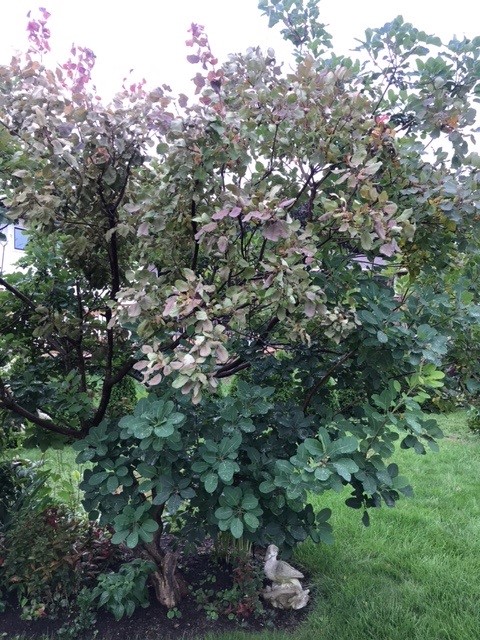
Good morning, I moved to St. Catharines recently and have, what I believe to be some sort of Smokebush tree, in my backyard. Some branches of leaves all seem to be drying up – I’ve cut off many affected branches with dried up leaves off, but worry about this set of branches will essentially ruin the tree (right in the middle) if I cut them off and would like to know if you believe it is Verticillium Wilt. What should I do? Also I planted a red point maple tree about 10′ away and worried about it being affected too (if it is a soil problem). I water the tree and plants around it regularly – this summer has been particularly hot so I water all my plants sometimes daily if it has been a particularly extremely hot daty. Can you please advise if you think this is Verticillium Wilt and what I should do with this tree? It’s a major feature of my backyard, I would like to save it if possible but don’t know what is wrong with it.
Thank you for contacting the Toronto Master Gardeners about your smokebush (Cotinus coggygria). Based on your description, it could be Verticillium wilt that has infected your tree but definitive diagnosis requires lab testing. Smokebush is quite susceptible to this disease. Symptoms of Verticillium wilt can be confusing because they are so variable. The most commonly observed symptoms include marginal leaf scorch, leaf wilting, vascular staining and branch dieback. Vascular staining is a pretty good indicator of the presence of Verticillium wilt. If the bark is scraped away on wilted branches or if you cut through them, you can sometimes see a green to brown streaking, although this is not always apparent. Verticillium wilt may completely kill the tree or shrub in one growing season or cause damage to only a part or parts or one side of the plant. Trees can go through years where no symptoms are present and then the symptoms show up again. Some trees can struggle along for years, while others may die soon after symptoms appear.
Verticillium wilt is caused primarily by two fungi, Verticillium dahliae and Verticillium albo-atrum. These fungi are in the soil and enter trees and shrubs through their roots and grow in the xylem that transports water throughout the plant. These fungi block the movement of water which eventually leads to wilting. Once Verticillium wilt has caused the disease it produces microsclerotia which are black-colored resting structures that resemble a small seed. They allow the pathogen to overwinter in dead plant tissues and when produced in the roots, allow the fungi to persist for many years in the soil at the planting site.
Verticillium wilt can be managed for a period of time by pruning out infected branches as you have been doing and with proper watering and fertilization based on a soil test. There is no cure for this disease. The best option for infected trees and shrubs is often plant removal and replacement with a tree or shrub that is resistant. If it is Verticillium wilt that is present in your garden then your maple is also at risk because maples are also susceptible to this disease. There is no guaranteed way to get rid of the fungi once the soil has been colonized.
The University of Guelph does soil testing that can confirm the presence of Verticillium wilt. There is more information here.
Below are lists of plants that are susceptible to Verticillium Wilt and plants that are resistant to this disease.
Plants susceptible and plants resistant to Verticillium wilt
And lastly, we suggest that you contact the Master Gardeners of Niagara for any additional information they might have about the presence of Verticillium wilt in the area where you live. Their website is here.

